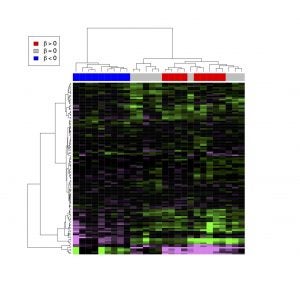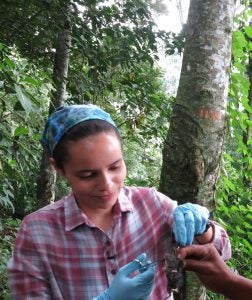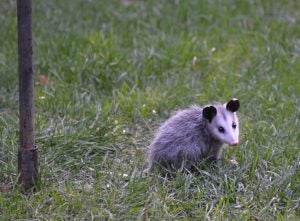What are the genetic/genomic underpinnings of the species boundary in house mice?
Priscilla Tucker
 My research program is shaped by my interests in biological diversity and the evolutionary processes that give rise to it. More specifically, I am interested in the genetic changes underlying mammalian diversity. Recent research is focused on understanding gene dynamics in hybrid populations of three subspecies of house mice, Mus musculus musculus and Mus musculus domesticus and Mus musculus castaneus. These mice are related to the laboratory mouse, a premier model for studies in mammalian genetics.
My research program is shaped by my interests in biological diversity and the evolutionary processes that give rise to it. More specifically, I am interested in the genetic changes underlying mammalian diversity. Recent research is focused on understanding gene dynamics in hybrid populations of three subspecies of house mice, Mus musculus musculus and Mus musculus domesticus and Mus musculus castaneus. These mice are related to the laboratory mouse, a premier model for studies in mammalian genetics.
Studying naturally occurring hybrid populations provides an opportunity to study the fitness consequences of genetic exchange between lineages that have presumably evolved in allopatry. We are interested in identifying genes that disrupt reproduction or development in hybrids, resulting in postzygotic isolation and speciation. We are also interested in identifying genes that are introgressing from one population to the other as they likely confer fitness advantages. Although reproductive isolation and adaptive introgression are opposing forces, both are likely to promote biological diversity when the genome is porous and the species boundary is semi-permeable.
Our most recent research on house mouse hybrid populations is a continuation of an earlier study on a naturally occurring hybrid zone between M. m. musculus and M. m. domesticus in southern Germany (Tucker et al., 1992). We measure differential gene flow in hybrid populations using genetic markers from across the genome. Our original study included seven genetic markers and 400 mice collected from a single transect in southern Germany. We have since increased the number of markers to 1403, providing a greater opportunity to pinpoint genes and identify phenotypes associated with reproductive isolation and adaptive introgression. We have also increased the number of transects sampled, allowing us to more effectively distinguish between selection and stochastic effects. Our future plans include a study of hybrid populations of M. m. musculus and M. m. castaneus in China. Recent papers from our lab that are related to this work include Teeter et al. (2008), Teeter et al. (2010), Wang et al., (2011), Janousek et al. (2012;2015) and Kass et al. (2014).
What are the genetic/genomic underpinnings of the species boundary in howler monkeys?
 In collaboration with my co-advisor Liliana Cortés Ortiz, I am studying the genetics of hybridization and speciation in howler monkeys. I am using genome-wide data in a natural hybrid zone (Alouatta palliata X A. pigra) to identify loci that underlie reproductive isolation and to understand their mechanism of divergence. I am also interested in the role of sex chromosome evolution in speciation and I am using deep resequencing to try to identify the evolutionary breakpoint for the neo-sex chromosome in A. palliata. I am also leading a project to reconstruct the howler monkey phylogeny using genomic data.
In collaboration with my co-advisor Liliana Cortés Ortiz, I am studying the genetics of hybridization and speciation in howler monkeys. I am using genome-wide data in a natural hybrid zone (Alouatta palliata X A. pigra) to identify loci that underlie reproductive isolation and to understand their mechanism of divergence. I am also interested in the role of sex chromosome evolution in speciation and I am using deep resequencing to try to identify the evolutionary breakpoint for the neo-sex chromosome in A. palliata. I am also leading a project to reconstruct the howler monkey phylogeny using genomic data.
What landscape characteristics influence rodent population connectivity in agricultural systems?
 Agricultural production is expanding throughout the tropics. Most natural forests in this region now exist as fragments embedded within an agricultural matrix. Beatriz is interested in understanding the role of this agricultural matrix in maintaining population connectivity and biodiversity. For her dissertation Beatriz is exploring the effects of different coffee management practices on two common tropical rodents: Heteromys desmarestianus and Peromyscus gymnotis. In her research she integrates landscape and genetic data to answer this question.
Agricultural production is expanding throughout the tropics. Most natural forests in this region now exist as fragments embedded within an agricultural matrix. Beatriz is interested in understanding the role of this agricultural matrix in maintaining population connectivity and biodiversity. For her dissertation Beatriz is exploring the effects of different coffee management practices on two common tropical rodents: Heteromys desmarestianus and Peromyscus gymnotis. In her research she integrates landscape and genetic data to answer this question.
Co-advised by Priscilla Tucker and John Vandermeer.
What factors are driving the Virginia opossum’s ongoing northward expansion?
 The Virginia opossum (Didelphis virginiana) has been expanding its range northward in North America for the past centuries, encountering new communities and harsher winter climates. We are evaluating the genetic patterns and ecological variables facilitating this on-going range expansion. By using contemporary samples collected by Lisa Walsh and fur trappers, along with museum samples, we are analyzing the opossum’s phylogeography and diet variation throughout their range.
The Virginia opossum (Didelphis virginiana) has been expanding its range northward in North America for the past centuries, encountering new communities and harsher winter climates. We are evaluating the genetic patterns and ecological variables facilitating this on-going range expansion. By using contemporary samples collected by Lisa Walsh and fur trappers, along with museum samples, we are analyzing the opossum’s phylogeography and diet variation throughout their range.

